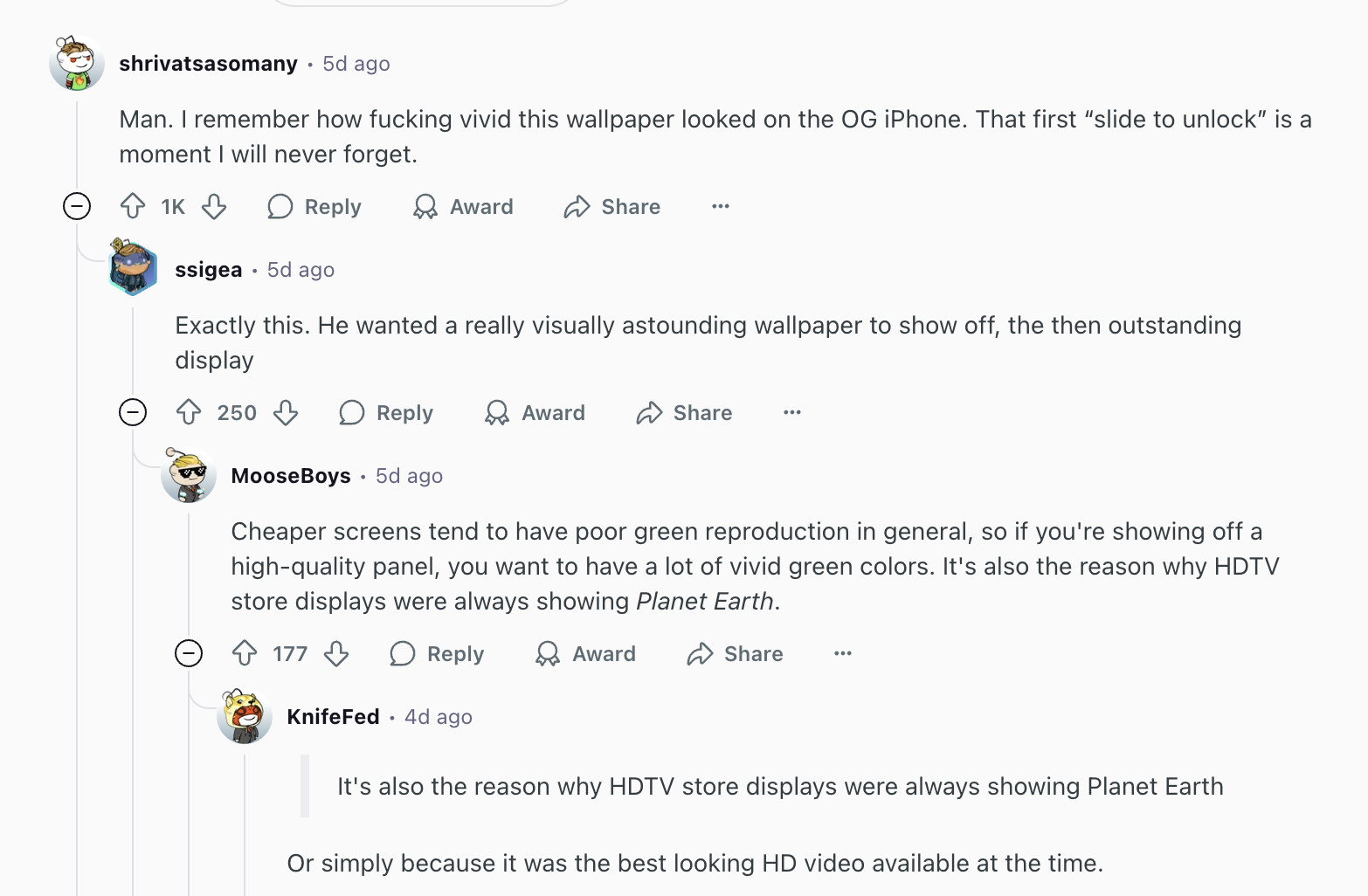On Environmental Aesthetics
Created: Fri Jun 20 2025
Overview
In the past, the philosophy of aesthetics was synonymous with the philosophy of art. This meant that conversations around other aesthetic experiences were absent, particularly our appreciation for nature. Now, environmental aesthetics is its own sub-branch of aesthetics, but it's still widely discussed in relation to art.
Dating back to the 18th century, terms like picturesque and sublime were used to describe our aesthetic experience with nature through paintings. These terms come from the position of disinterestedness and formalist views. In other words, it was a way for people to separate their personal desires and interests and have an objective framework by focusing on qualities that we can see, such as colour and composition.
This landscape/scene model can be helpful with what we find beautiful, and what we find beautiful can lead to environmental protectionism and activism. But this beauty can also detract us from what we might visually deem undesirable. This is a problem because what we see as "ugly" can be beneficial to an ecosystem. For example, wetlands or marshes aren't a tourist attraction in comparison to a majestic mountain or a lush forest with lively fauna and flora.
Perhaps the most obvious observation is that nature is not art and that they are indeed two different domains and should be treated as such. The question then, how are they different? The biggest difference that comes up in this discussion is that art is framed while nature is unframed, and this is also a critique to the landscape model. Art, in the case of paintings, is framed and placed on walls. There is a literal frame and also the context they are in. In addition, there's framing of what we consider art and the literature and text that goes with it. In contrast to nature, nature is boundless, and it's difficult to define where one environment begins and ends.
In the article Contemporary Aesthetics and the Neglect of Natural Beauty by Ronald Hepburn, he states that when we realize an experience or object, this is where our appreciation comes from. He uses an example of reading a series of words which could be gibberish, or it could be poetry. When primed or informed that it's poetry, we have a different reaction to it. It's this realization of knowing what it is which allows us to appreciate it for what it is.
This realization, or this knowing, is also expanded on by Allen Carlson with his Natural Environmental Model (NEM). Carlson argues to appreciate nature, like art, we need to understand where they are coming from. For art, there's art history and art theory, and for nature, there's natural history and sciences. With this scientific knowledge, we can better understand and also appreciate nature, according to Carlson.
The cognitivist view has been rebutted because it neglects our appreciation through emotions, imagination, literature, mythology, and folklore. And as Thomas Heyd mentions in Aesthetic Appreciation And The Many Stories About Nature, scientific knowledge is neutral and negates our personal relationship to nature, which can be a more powerful experience and motivator for us to appreciate nature.
Heyd also criticizes aetiology, the study of causes and origins, by making an analogy to packaging labels. We can enjoy a delicious bottle of wine without having ever known its origins. What the label provides is context, similar to how art history provides context to an artwork. The aetiology of a natural object becomes secondary.
While the cognitivist view is attractive because it helps streamline our understanding of nature and, in turn, appreciate it, we are denying ourselves the opportunity to explore and discover nature in a plethora of ways. It would also be incredibly boring if there were only one way to appreciate nature.
With that, here are some questions I have:
- How can technology facilitate our appreciation of nature and advocate for it?
- Can we truly understand nature? This question comes more so from Hepburn's statement about "humanizing"/"spiritualizing" nature. That is, we are projecting what's in our minds onto nature. It's through our lens. We also project emotions onto nature when nature is not being emotional, or not capable of being emotional. Where I'm trying to get at is that if we cannot truly understand nature, then how can we advocate for it? This is more so from the point of view of creating legal entities for nature or using sounds to represent nature's voice.
Below are some preliminary texts to help make a connection between environmental aesthetics and technology.
Picturesque & Apple
Picturesque once meant painterly since it was coined during the 18th century to describe the prominent visual medium of the time, which were paintings. To be specific, the painterly quality meant there were expressiveness in brush strokes to caputre the wilderness of nature and softer colours to reflect the more elusive qualities of nature. Picturesque can also simply mean, picture-like. In the most straightforward way, it's representing a landscape and its beauty.
One of the founding concepts of Environmental Aethetics, still has a role in contemporary life even if landscape paintings have fell out of fashion. Instead, digital photography has become ubiquitous. Instead, of talking about the different qualities that digital photography has that paintings don't, I would like to specifically highlight the use of landscape photography within the context of Apple, the American tech company that revolutionized how we use computers and mobile devices.
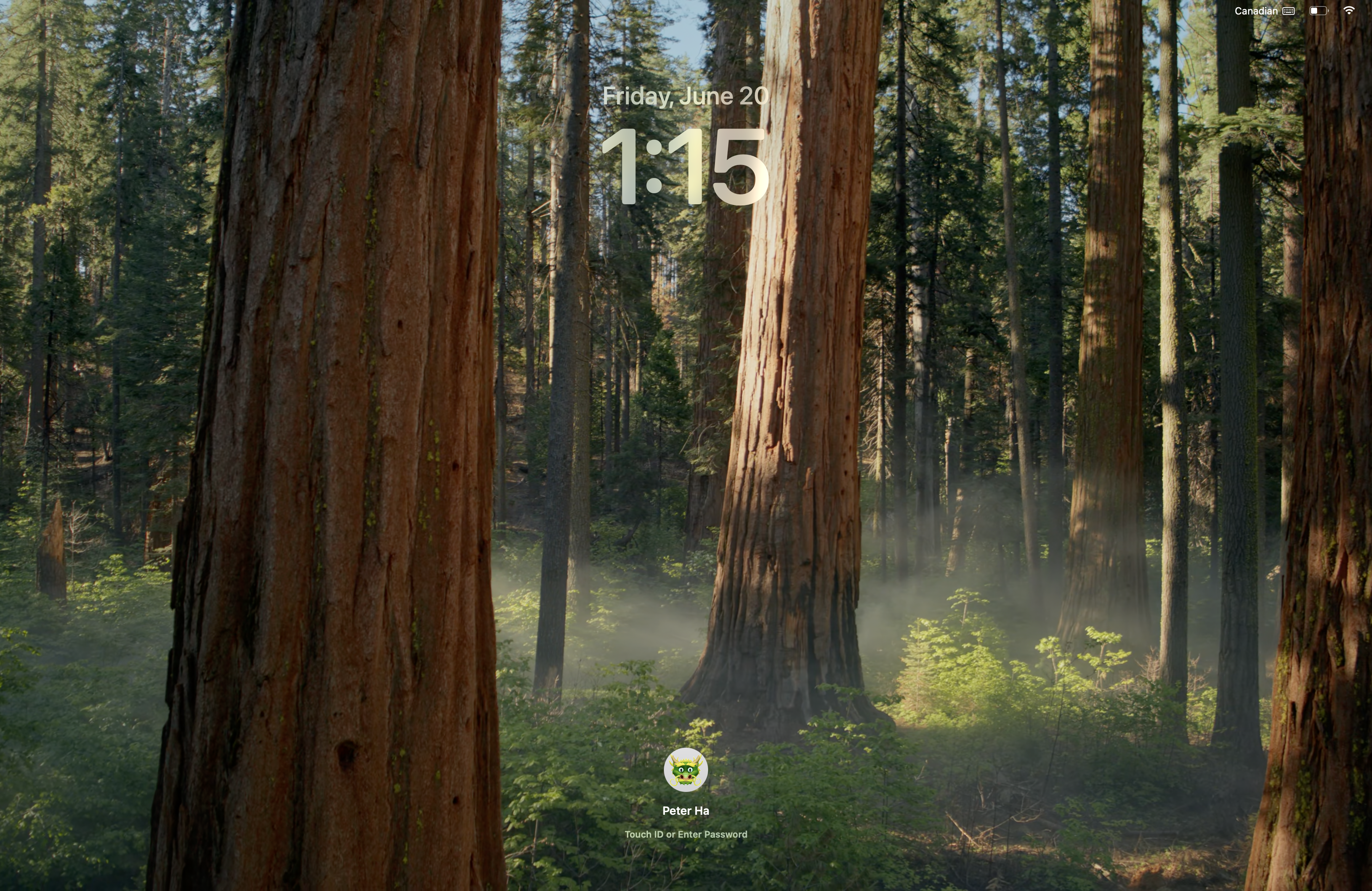 MacOS Sequoia 15 Lock Screen
MacOS Sequoia 15 Lock Screen
The latest desktop operating system from Apple is named Sequoia which comes from a Californian National Park. This follows the pattern of previous OS names up to OS X Mavericks (10.09). Before, they were named after different types of felines. The naming convention to base it on natural landmarks and places in California is one way to show patriotism and pride for where the company is founded and based. It's also a way to package default wallpapers that features stunning landscapes to contrast the sterile, silver devices they live on.
List of Operating Systems from Apple since 2013
- macOS Sequoia (15): Released September 18, 2024
- macOS Sonoma (14): Released September 26, 2023
- macOS Ventura (13): Released October 24, 2022
- macOS Monterey (12): Released October 25, 2021
- macOS Big Sur (11): Released November 19, 2020
- macOS Catalina (10.15): Released October 7, 2019
- macOS Mojave (10.14): Released September 24, 2018
- macOS High Sierra (10.13): Released September 25, 2017
- macOS Sierra (10.12): Released September 20, 2016
- OS X El Capitan (10.11): Released September 30, 2015
- OS X Yosemite (10.10): Released October 16, 2014
- OS X Mavericks (10.9): Released October 22, 2013
Seeing the image static doesn't really do it justice because the subtle movement of the dynammic wallpaper creates an immersive sensation. It makes it feel like the image is alive and for a small amount time, you might feel like you've been transported to the park with these beautiful Sequoia trees.
Above, you can get a little taste of what I see on a daily basis. However, technological devices are not all made equal. Seeing this video will not be the same for everyone. It depends on Internet speed, device screen size and quality. Perhaps another reason why Apple chose to display landscape photos is to also higlight their retina screen technology which displays close to 4k for their laptops. This means you can view images and videos at high resolution, making the visual appear realistic.
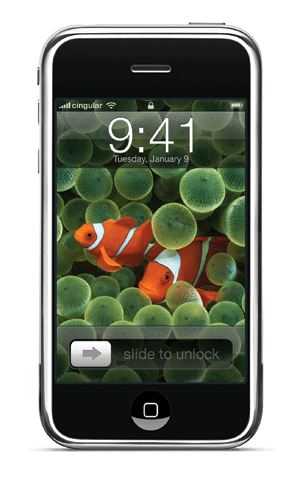
When revealing the first iPhone in 2007, Steve Jobs had a wallpaper that displayed two orange clownfish nestled in a sea of green anemone. The iPhone acting as an aquarium, framing the two perfectly composed clownfishes. But of course, this was shown at a conference to announce a product and to highlight once again the quality of the screen.
Picturesque images are no longer just for the aesthetic value, that is, for its beauty, but instead they have been co-opted from companies to highlight their screen technologies. As a consumer, it's a way for us to feel connected to nature, even if its through a screen. For me, it creates a relaxing feeling, even if it's for a fleeting moment before getting into the hustle and bustle of everyday life.
Scenic Tourism & Media
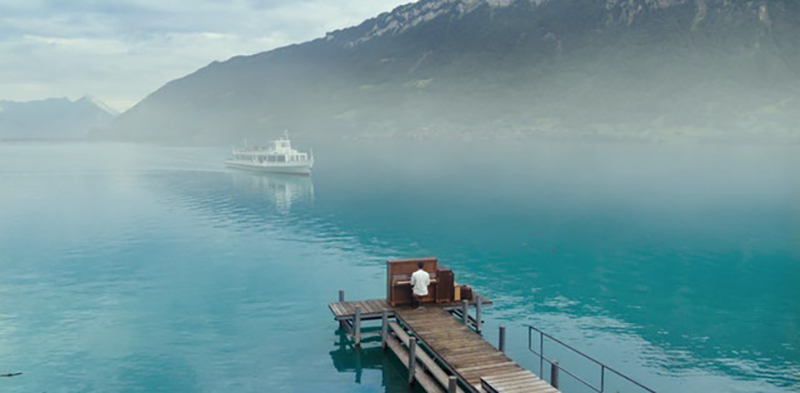 Crash Landing on You
Crash Landing on You
Switzerland, known for its beautiful landscapes is no shy to tourists. With the power of tv & film coupled with social media, Iseltwald, a small Swiss alpine village with 400 inhabitants has recently become the latest hot spot among tourists. Made popular by a Korean Drama tv show "Crash Landing on You". The pier and Lake Brienz serves as a beautiful backdrop to the love story between a South Korean heiress and a North Korean army officer.
The desire to visit the location is not just the beauty of the landscape, but through the story that has been told. This would align with Postive Aesthetics and Yuriko Saito's perspective that stories is what drives us to find value in the landscape.
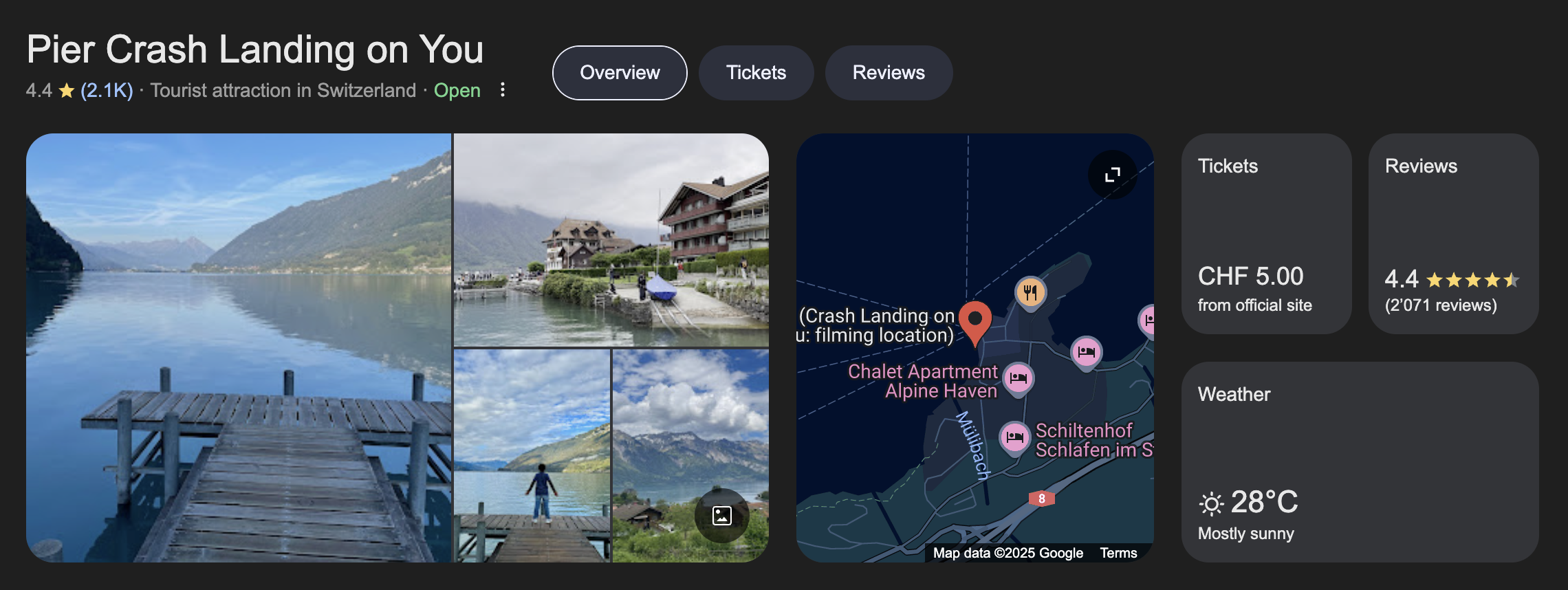 Google Reviews
Google Reviews
The location has become so popular that the Iseltwald's Mayor Rubi installed a turnstile where tourists have to pay CHF 5 access the pier. The reasons given was for maintenance of roads and washrooms, but nothing about environmental protection. The Mayor is hoping to make 100,000 CHF / year to sustain the maintenance work. In addition, the location has become so popular that it has become a tourist attraction on Google with reviews.
Ecological Media Art Exhibitions
There's a publication called Coding Care: Towards a Technology for Nature and the opening statement mentions these exhibitions while the articles in the publication is around the Earthbound exhibtion. Would like to examine these a bit further through different concepts within Environmental Aesthetics such as Natural Environmental Model (NEM) and Ecological Aesthetics to better understand where we are today with eco-media art.
Ecomedia (2008)
Focused primarily as data collection and analysis which was a trend 10 years ago. Looking at nature through data, which aligns with the Nature Environmental Model because it's scientifically looking at the environment to better understand it. Ex. monitoring water quality.
Eco-Visionaries. Art, New Media, and Ecology After the Anthropocene (2018–2020)
A perhaps gloomier look on the environment as the name suggests. If there's no reversing the effects of the damage done to Earth through human systems, then what does it mean to live in this new ecological state? This is what the exhibition is trying to examine.
Earthbound. In Diagloue with Nature (2022)
From this article: "Many of the works were created in interdisciplinary collaborations between artists and scientists from a wide range of fields including geology, meteorology, and oceanography. Technology can often appear detached. Yet, while the artists participating in this exhibition do not advocate that technological solutions alone can guarantee a “better” future, or save the planet, they all employ technology to enlighten. This enables us to become aware of otherwise invisible ecological processes, therefore contributing to better coexistence with our environment."
This again aligns with the NEM but also perhaps on ecological aesthetics since the ecological operation, or processes, is present. What is maybe missing is the ecological value. This would require a deeper study of the artworks in the exhibtions to validate this statement.
From the exhibition description, it's also noted that the works were created interdisciplinary and in collaboration with scientists from geology, meteorology, and oceanography. When it comes to eco-art, is it possible for an artist to ever create in isolation from other disciplines, specifically science?
The Smokey Sublime
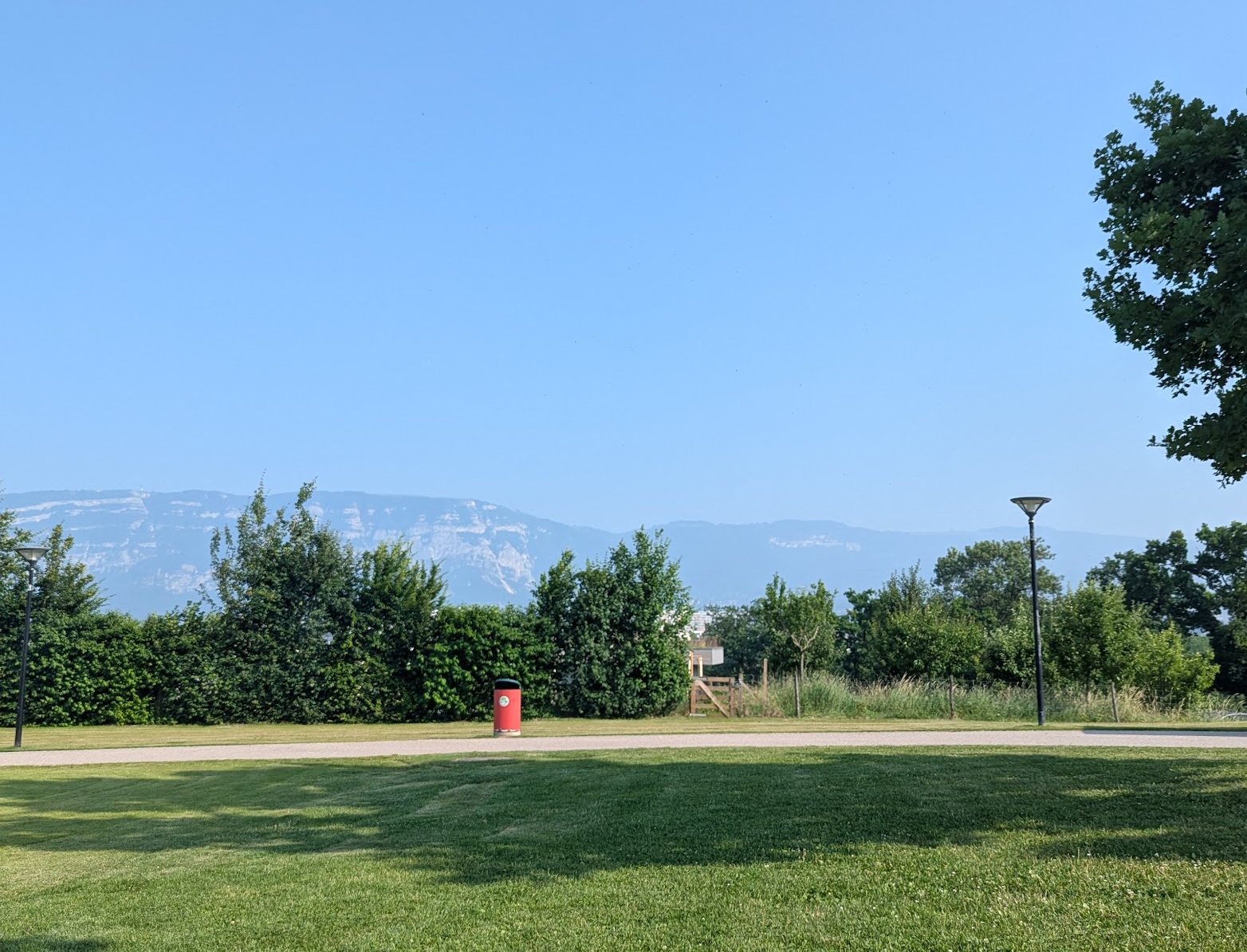 Hazy Mont Salève, View from Geneva
Hazy Mont Salève, View from Geneva
Recently, Geneva was shrouded with smoke, producing an eerie red sun with a hazy mountainious landscape. The smoke didn't come from Switzerland, instead, it was from a westcoast wildfire in Canada. This means, the smoke travelled across Canada, the Atlantic ocean, and made an impact to the inhabitants on another continent. I remember seeing the red sun one morning, not knowing why it was unusal that morning, but I did think to myself, "Oh, that's pretty". Only later, when a friend told where the smoke came from I realized perhaps the smoke was caused from climate change.
This was also the same sentiment from another friend when talking about the smoke. They acknowledged that it was something to marvel over but the moment I was about to be mention that it's probably not a good thing because it's from a wildfire, they also changed their reaction to show disapprovement. How are we to make sense of this new reality of being interconnected globally while understanding the terriying beauty comes from environmental damage? Also, can we acknowledge the beauty yet still take action?
According to this "One view, for instance, holds that finding beauty in the environmental damage brought about by our negligent practices represents a tacit approval and encouragement of those very practices (Foster 1992)." I wonder if we can existence in the beautiful disaster while still taking action.
 Smoke Covering Hanoi, View Reddit Thread
Smoke Covering Hanoi, View Reddit Thread
If you've ever been to Vietnam, you'll know that smoke is prevalent there. Not only for the cigarettes but as a byproduct of buring trash. I'm use to seeing it in the countryside but haven't witnessed it at a large scale in an urban environment.
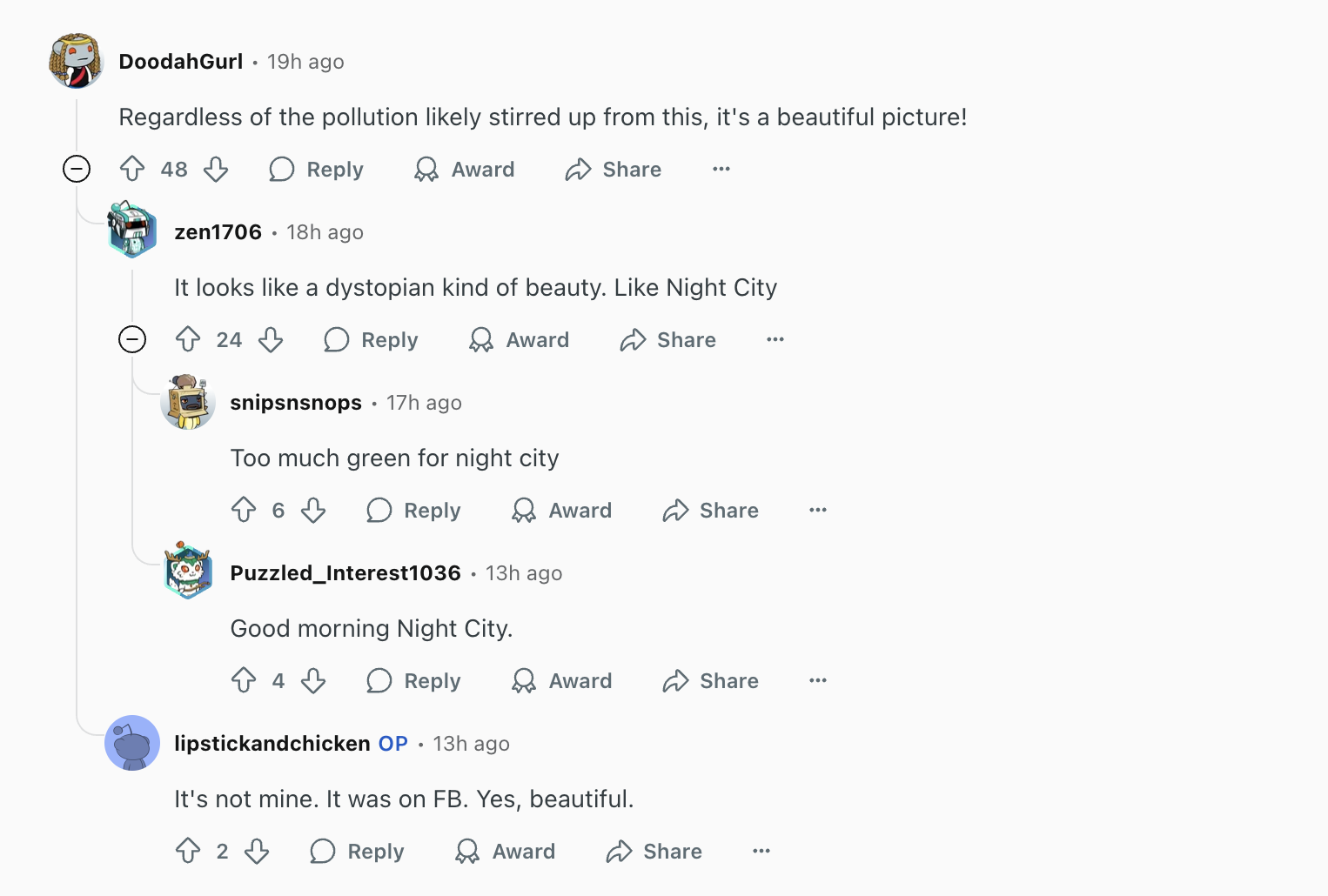
According to some Redditors, they acknowledge the pollution that's caused by this practice while noting its beauty. However, they do not mention that people should discontinue burning trash.
Bibliography
HEPBURN, Ronald, 2004. Contemporary Aesthetics and the Neglect of Natural Beauty. In: CARLSON, Allen and BERLEANT, Arnold, eds. The aesthetics of natural environments. Peterborough, Ont.; Orchard Park, NY: Broadview Press, pp. 49–66. ISBN 978-1-55111-470-5.
HEYD, T., 2001. Aesthetic Appreciation And The Many Stories About Nature. The British Journal of Aesthetics. Vol. 41, no. 2, pp. 125–137. DOI 10.1093/bjaesthetics/41.2.125.
How a Korean Netflix series made a Swiss town a tourist spot – DW – 11/26/2024, dw.com [online]. Retrieved from : https://www.dw.com/en/how-a-korean-netflix-series-made-a-swiss-town-a-tourist-spot/video-70796803 [accessed 20 June 2025].
MAGRINI, Boris et al., 2022. Coding care: towards a technology for nature. Berlin : Hatje Cantz Verlag. Zeitgenössische Kunst. ISBN 978-3-7757-5456-9.
PARSONS, Glenn and CARLSON, Allen, 2024. Environmental Aesthetics. In : ZALTA, Edward N. and NODELMAN, Uri (eds.), The Stanford Encyclopedia of Philosophy [online]. Fall 2024. Metaphysics Research Lab, Stanford University. Retrieved from : https://plato.stanford.edu/archives/fall2024/entries/environmental-aesthetics/ [accessed 15 June 2025].
← Back to garden